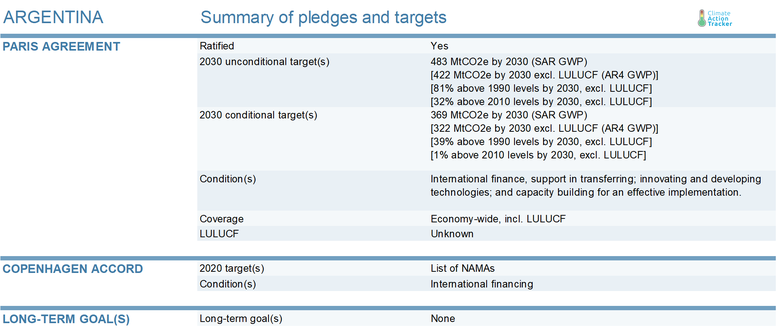Pledges And Targets
Summary table

Paris Agreement targets
NDC update: In December 2020, Argentina submitted an updated NDC. Our analysis of its new proposed target is here.
Argentina’s NDC, submitted in 2016, includes two absolute emissions reduction targets for 2030 (Government of Argentina, 2016a). The unconditional target limits emissions to 483 MtCO2e in 2030 including LULUCF and, according to our calculations, to 422 MtCO2e in 2030 (excl. LULUCF and recalculated using Global Warming Potentials (GWP) from the IPCC Fourth Assessment Report (AR4)). This unconditional target is equivalent to 32% above 2010 levels and 81% above 1990 levels excluding LULUCF.
The conditional target, including LULUCF, limits emissions to 369 MtCO2e in 2030 and, according to our calculations, to 322 MtCO2e in 2030 (excl. LULUCF and recalculated using GWP from IPCC AR4). This is equivalent to a 1% increase above 2010 levels and 39% above 1990 levels, excluding LULUCF.
Argentina is in the process of developing its national long-term low GHG emissions development strategy (LTS) for submission to the UNFCCC, which is expected to be presented before the end of the year. Once this LTS process is completed, the government intends to use the new LTS to inform the NDC revision process scheduled for 2021 (Secretaria de Ambiente y Desarrollo Sustentable, 2019). This timeline should be moved forward and a stronger target consistent with the Paris Agreement temperature limit should be submitted in 2020.
CAT ratings are based on emissions excluding the LULUCF sector. To obtain the NDC emissions level excluding LULUCF, the CAT assumes that the share of the LULUCF emissions in 2030 will be similar to the share of these emissions in the NDC’s BAU scenario.
2020 pledge
Argentina submitted a list of unilateral and supported mitigation actions being undertaken across the energy efficiency, renewable energy, biofuels, forest management and waste management sectors. According to the submission “these initiatives have a direct and positive consequence in the emission reduction of GHG, contributing to the ultimate objective of the Convention” (Secretariat of Environment and Sustainable Development, 2010).
Further analysis
Latest publications
Stay informed
Subscribe to our newsletter




